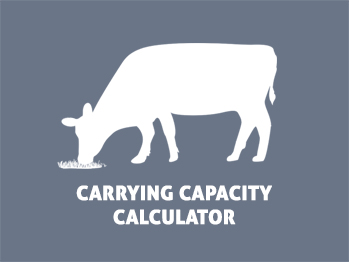Two Methods, Four Steps for Calculating Carrying Capacity 🎙️
CLICK THE PLAY BUTTON TO LISTEN TO THIS POST:
Listen to more episodes on BeefResearch.ca, Spotify, Apple Podcasts, Amazon Music or Podbean.
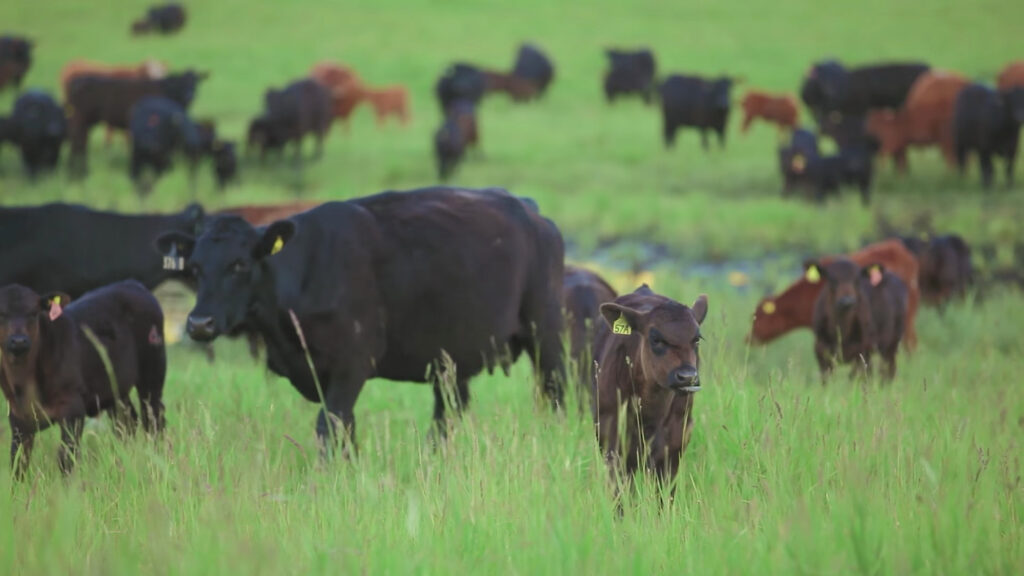
Carrying capacity, also known as grazing capacity, is the amount of forage available for grazing animals in a specific pasture or field. Calculating the correct carrying capacity will help you determine a proper stocking rate that maintains productivity of both your animals and forage while encouraging the sustained health of the grassland resources.
One way to determine carrying capacity is to obtain past stocking rates and grazing management information and assess the condition of the pasture. But what if the historical stocking rate data is not available or you are unsure of its accuracy and reliability?
Carrying capacity can be calculated using several different techniques. All of them depend on some trial and error as they are monitored and adjusted over time.
Stocking rate is the number of animals on a pasture for a specified time period and is usually expressed in Animal Unit Months (AUMs) per unit area.
When calculating carrying capacity, it boils down to three questions:
- How much forage is available?
- How much of that forage can be used by grazing animals?
- How many animals can graze on that piece of land and for how long?
Method #1 – Use Provincial Guides
The BCRC Carrying Capacity Calculator provides a road map for answering these questions using two separate methods: 1) forage estimates based on provincial guides and 2) field-based sampling, also known as the clip and weigh method. Each method contains four steps.
This method is based on available provincial forage production guides. It is easy to use and works best when the pasture condition (or range health) is similar throughout the field and the forage plant community (or range type) is uniform.
Data for this method is currently only available for western Canada. If forage yield data becomes available for eastern regions, the calculator will be updated. Click here if you would like to skip to method 2.
Step 1: Determine Pasture Condition
The tame pasture condition class definitions (Table 1) provide general descriptions in classifying tame pastures (Excellent, Good, Fair or Poor).
Table 1. Tame pasture condition class definitions
| Category | Excellent | Good | Fair | Poor |
|---|---|---|---|---|
| Potential yield of the area | 75-100% | 60-75% | 50-60% | 33-50% |
| Production from desirable, adapted grass and legumes | 95% | 90% | 60% | Less than 50% |
| Production from weeds or undesirable plants | Less than 5% | Less than 10% | 20% or more | 50% or more |
| Fertility program | Average to above average | Average | Below average or non-existent | No fertility program |
Guide to Range Condition and Stocking Rates for Alberta Grasslands
Step 2: Estimate Forage Yield
Once the pasture condition has been determined, forage yield can be estimated based on that information and the precipitation zone for the location. For example, if pasture condition is good and precipitation of the zone is at 14-18 inches, the estimated forage yield is 740 lbs/ac.
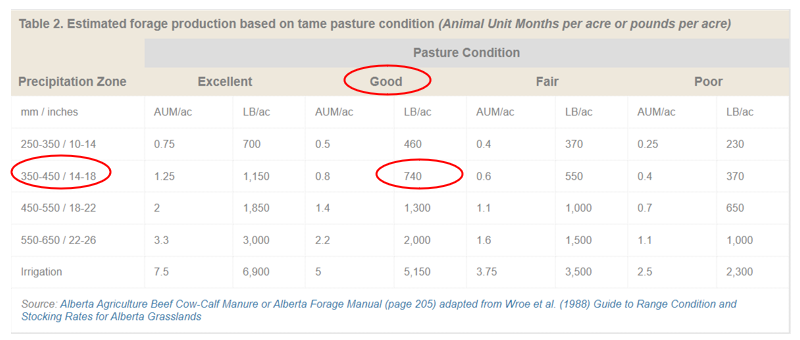
It should be noted that the estimated forage yield table (Table 2) is based on Alberta tame pasture data and may not be applicable to rangeland (i.e., native grass) and other provinces. These averages assume average inputs and a continuous grazing method. Higher carrying capacities may be achieved when using a fertility program or more intensive grazing methods.
For native range, you can use the appropriate provincial guide to determine the forage yield for your soil zone or ecosite and recommended stocking rates. Provincial guides are available at:
- British Columbia Rangeland Ecology
- Alberta Ecological site and community guides, Range Reference Areas
- Saskatchewan Rangeland Ecosystems: Ecosite Guide (2015)
- Manitoba Rangeland Classification
Step 3: Calculate Available Forage
Utilization rates refer to the old adage “it takes grass to make grass.” Allowing sufficient carryover post-grazing will help a pasture recover more quickly and prevent problems such as reduced forage productivity or the establishment of invasive or undesirable plants.
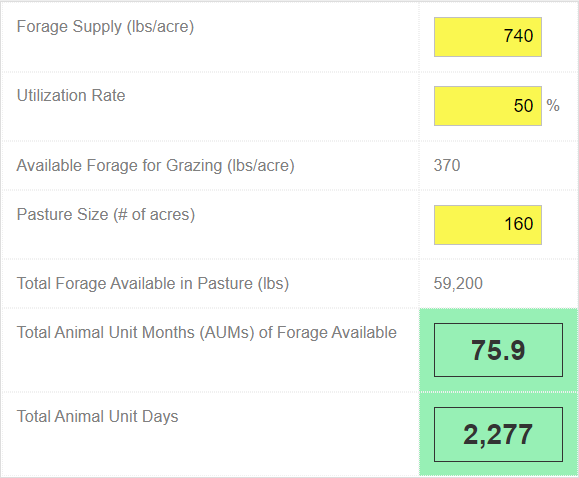
Once forage yield has been estimated, we need to determine the appropriate utilization rate of the forage for grazing. The utilization rate determines how much forage material should be left behind to maintain future production. Utilizing pasture at a rate that exceeds the plant communities’ ability to recover can lead to lower forage production and encourage less palatable/productive forage plants to invade the pasture.
Recommended utilization rates for native pastures vary from 25-50%. For tame pastures, recommended utilization rates range from 50-75% depending on fertility and rainfall.
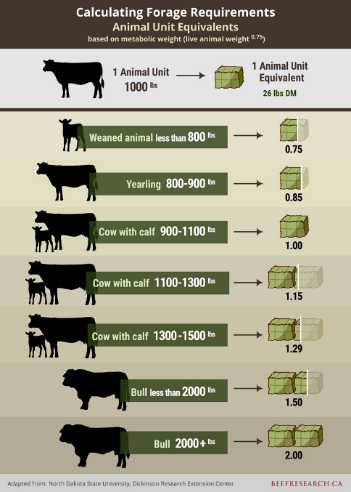
The amount of available forage is calculated using Animal Units of Animal Unit Months. An Animal Unit (AU) is a standard unit used in calculating the relative grazing impact of different kinds and classes of livestock. One animal unit is defined as a 1,000-pound beef cow with or without a nursing calf, with a daily dry matter forage requirement of 26 lbs.
Animal Unit Month (AUM) is the amount of forage to fulfill metabolic requirements by one animal unit for one month (30 days). One AUM is equal to 780 pounds of dry matter forage.
Pasture size is needed to calculate total forage available in a particular paddock or grazing area. If the pasture size is 160 acres, estimated forage yield is 740 lbs/ac, and utilization rate is set at 50%; total forage available for grazing is estimated at 59,200 lbs. The calculator then determines that this pasture can provide approximately 76 AUMs or 2,277 animal unit days of grazing.
Step 4: Calculate the Number of Animals that Can Graze
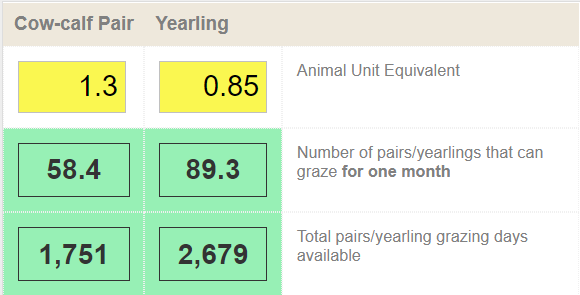
Different classes, or sizes, of cattle consume different amounts of forage, with bigger animals eating more available forage. For example, a yearling steer is equivalent to 0.85 AU while a 1,300-pound cow, with calf at side, is estimated at 1.3 AUs. In step 4, we need to know the average weight of the grazing animals to determine and enter their equivalent animal units (AU).
Following is an example using Method 1 to calculate carrying capacity. The example is based on the Alberta tame pasture condition and estimated forage yield tables (Table 1, 2).
Example 1: A 160-acre tame pasture in Alberta
1. Determine pasture condition: Good
2. Estimate forage yield (using Table 2)
- Precipitation of the zone: 14-18 inches
- Estimated forage yield is estimated at 740 lbs/ac
- How much forage is available?
- 740 lbs/ac x 160 ac = 118,400 lbs
3. Calculate available forage
- Forage Utilization Rate: 50%
- How much of that forage can be used by grazing animals?
- 118,400 lbs x 50% = 59,200 lbs
- In Animal Unit Days (AUD) 59,200 lbs ÷ 26 lbs/day = 2,277 AUDs
- In Animal Unit Months (AUM) 2,277 AUDs ÷ 30 days = 76 AUMs
4. Calculate the number of cattle that can graze
- Cow-calf pairs at 1,200 lbs graze this field
- Animal unit per cow-calf pair: 1.3 animal unit equivalent
- How many cow-calf pairs can graze on that field for one month?
- 76 AUMs ÷ 1.3 animal units = 58 pairs
- 58 cow-calf pairs for one month
Method #2 – Field-Based Sampling
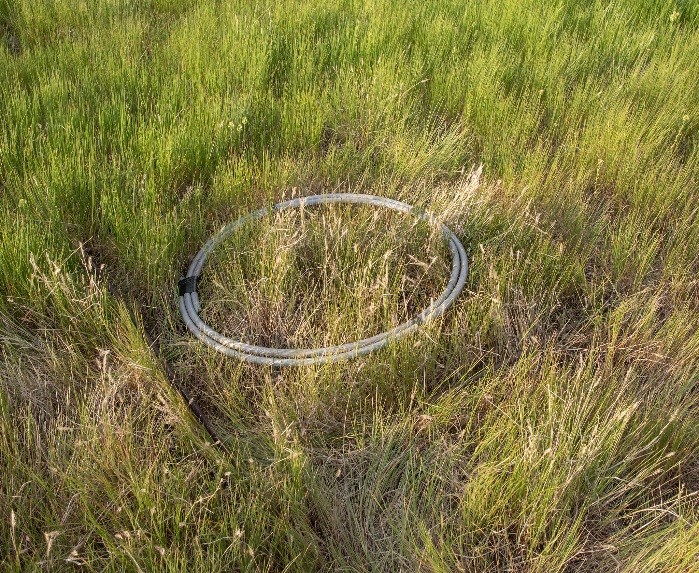
This method is also known as the clip and weigh method. It provides greater accuracy but requires more hands-on work. Producers may choose field-based sampling if provincial guides are unavailable for their region or if pasture types or conditions vary within their field. Forage production varies each year, so the Method 2 approach should include multiple years of sampling to estimate the long-term productivity of the pasture.
Step 1: Sampling
| Supplies needed:
|
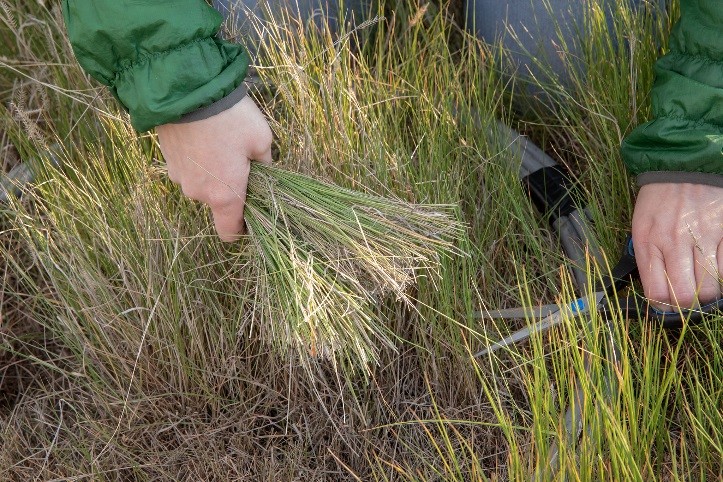
Clip samples of forage close to ground level within an area of 50 cm x 50 cm from representative areas of the pasture that have not been grazed. It’s best to clip during the typical grazing season, building up data from a number of years to get a picture of the average forage yield that is representative across varying weather conditions.
The number of samples taken will vary with the size of the field and how uniform or varied the forage production is. The goal is to take enough samples to capture the variation in the pasture to be representative of production across the entire field.
Step 2: Dry, Sort (optional), Weigh and Record
| There are other visual assessment methods for estimating forage production such as the falling plate meter. Resources are available in some provinces by contacting regional forage associations or extension specialists.
|
Dry grass clippings in a food dehydrator, or in an oven at about 100-120°F for one day or more, or at room temperature over several days. Make sure to keep sample bags contained and identified.
Weigh each bag for the total weight from each sample.
Sort the litter from the green material. This step is optional. Sorting litter from the green material will give more information and be more accurate compared to using total dry forage weight, but sorting is a time-consuming process. It is important to balance accuracy with time available. If a producer doesn’t have the time to do it or can’t commit to it on a consistent basis then it may not worth the effort. The BCRC Carrying Capacity Calculator uses the no-sort method – forage supply is estimated based on total dry forage weight, not the green material weight.

Record the weight of total dry forage in grams and enter into the yellow cells in the calculator. The record for green material weight is optional. Enter that data only if you went through the sorting process.
Step 3 and 4: Calculate Available Forage and the Number of Pairs or Yearlings That Can Graze
Step 3 and 4 of Method 2 are similar to Method 1.
In Step 3, the calculator coverts average dry forage weight from grams/0.25 square meter to lbs/acre for estimated forage supply. For example, the average dry forage weight of 52 grams/0.25 square meter is converted to 1,851 lbs/acre.
Enter your chosen utilization rate and the pasture size to calculate total forage available in the pasture. Then use the average weight of the grazing animals to determine and enter their equivalent animal units in Step 4 to calculate the number of cattle that can graze on that piece of land.
The following example calculates carrying capacity based on Method 2.
Example 2: A 160-acre pasture
1. Sampling
2. Dry, Sort, Weigh & Record
- Average total dry forage weight is 52 g/0.25 square meter
3. Calculate Available Forage
- Forage yield is estimated at 1,851.2 lbs/ac
- How much forage is available?
- 1,851.2 lbs/ac x 160 ac = 296,192 lbs
- Forage Utilization Rate: 50%
- How much of that forage can be used by grazing animals?
- 296,192 lbs x 50% = 148,096
- In Animal Unit Days (AUD) 148,096 lbs ÷ 26 lbs/day = 5,696 AUDs
- In Animal Unit Months (AUM) 5,696 AUDs ÷ 30 days =190 AUMs
4. Calculate the number of cattle that can graze
- Cow-calf pairs at 1,300 lbs graze this field
- Animal unit per cow-calf pair: 1.3 animal unit equivalent
- How many cow-calf pairs can graze on that field for one month?
- 190 AUMs ÷ 1.3 animal unit = 146 pairs
- 146 cow-calf pairs for one month
It should be noted that the two methods provided in the BCRC Calculator are not the only ways to calculate carrying capacity, and they can provide more robust insight when combined with more detailed management information (e.g., historic stocking rates, precipitation, range health monitoring).
Calculating carrying capacity is the starting point to understand how to balance forage supply and demand. Effective grazing management supports forage yield, animal health and productivity, all of which impact cost of production. It also benefits the pasture ecosystem. For more resources about grazing management and how to develop a grazing plan explore the following links:
- Grazing Management (BCRC webpage)
- Grazing Game Plan – How to Develop a Grazing Plan (BCRC webinar)
- Improving Pasture Utilization with Off-Site Watering Systems (BCRC webpage)
- Grazing Response Index (Agriculture and Agri-Food Canada webpage)
- Management of Canadian Prairie Rangeland (Agriculture and Agri-Food Canada webpage)
- Rangeland and Riparian Health (BCRC webpage)
Click here to subscribe to the BCRC Blog and receive email notifications when new content is posted.
The sharing or reprinting of BCRC Blog articles is welcome and encouraged. Please provide acknowledgement to the Beef Cattle Research Council, list the website address, www.BeefResearch.ca, and let us know you chose to share the article by emailing us at [email protected].
We welcome your questions, comments and suggestions. Contact us directly or generate public discussion by posting your thoughts below.
